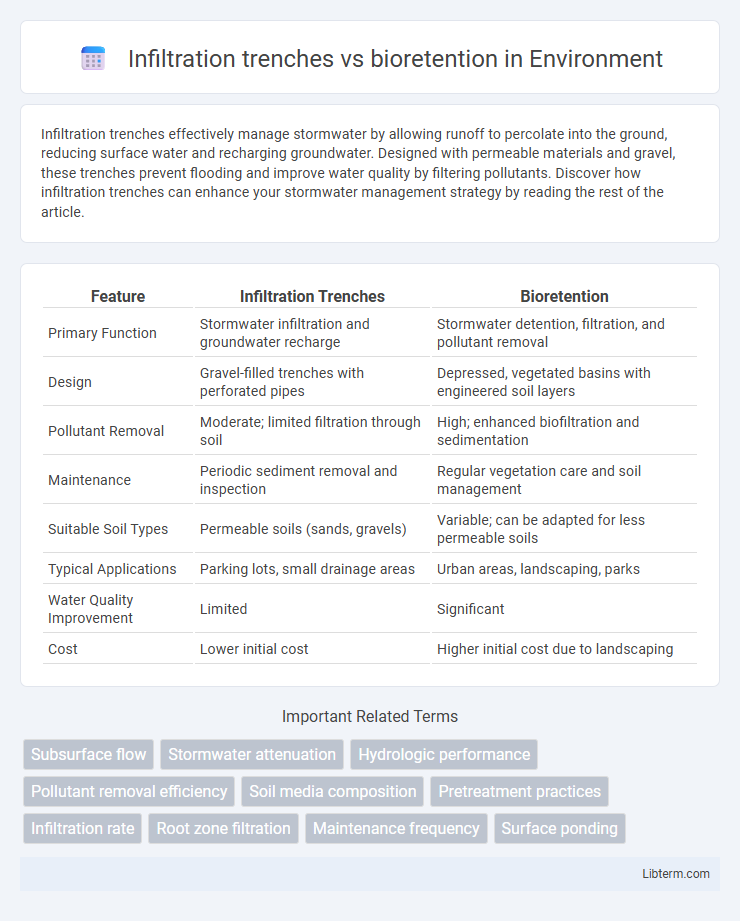Infiltration trenches effectively manage stormwater by allowing runoff to percolate into the ground, reducing surface water and recharging groundwater. Designed with permeable materials and gravel, these trenches prevent flooding and improve water quality by filtering pollutants. Discover how infiltration trenches can enhance your stormwater management strategy by reading the rest of the article.
Table of Comparison
| Feature | Infiltration Trenches | Bioretention |
|---|---|---|
| Primary Function | Stormwater infiltration and groundwater recharge | Stormwater detention, filtration, and pollutant removal |
| Design | Gravel-filled trenches with perforated pipes | Depressed, vegetated basins with engineered soil layers |
| Pollutant Removal | Moderate; limited filtration through soil | High; enhanced biofiltration and sedimentation |
| Maintenance | Periodic sediment removal and inspection | Regular vegetation care and soil management |
| Suitable Soil Types | Permeable soils (sands, gravels) | Variable; can be adapted for less permeable soils |
| Typical Applications | Parking lots, small drainage areas | Urban areas, landscaping, parks |
| Water Quality Improvement | Limited | Significant |
| Cost | Lower initial cost | Higher initial cost due to landscaping |
Introduction to Stormwater Management Solutions
Infiltration trenches and bioretention are innovative stormwater management solutions designed to mitigate runoff and improve water quality. Infiltration trenches utilize permeable materials to capture and infiltrate stormwater directly into the groundwater, while bioretention systems employ engineered soil media and vegetation to filter pollutants and enhance infiltration. Both strategies effectively reduce urban flooding and promote sustainable watershed management through natural hydrologic processes.
What Are Infiltration Trenches?
Infiltration trenches are engineered, gravel-filled trenches designed to capture and infiltrate stormwater runoff directly into the ground, promoting groundwater recharge and reducing surface water runoff. They are typically narrow, linear features installed in areas with suitable soil permeability and are designed to handle smaller runoff volumes by allowing water to percolate through the trench media and underlying soil. Unlike bioretention systems that rely on vegetation and soil layers for filtration, infiltration trenches primarily focus on rapid subsurface infiltration without significant pollutant removal processes.
What Is Bioretention?
Bioretention is a stormwater management practice that uses engineered soil layers and vegetation to capture, filter, and treat runoff, promoting groundwater recharge and pollutant removal. Unlike infiltration trenches that primarily allow water to percolate through a gravel-filled trench, bioretention systems incorporate plants and organic matter to enhance nutrient uptake and microbial activity. This combination of physical, chemical, and biological processes makes bioretention highly effective for reducing urban runoff impacts.
Design Differences: Infiltration Trenches vs Bioretention
Infiltration trenches are designed primarily for stormwater infiltration using gravel-filled trenches that promote rapid water percolation into the ground, whereas bioretention systems incorporate engineered soil media and vegetation to treat and filter runoff before infiltration. Bioretention designs typically include a layered soil profile with organic matter and may feature an underdrain system for controlled discharge, unlike the simpler gravel medium in infiltration trenches. The presence of plants in bioretention enhances pollutant removal through uptake and microbial activity, distinguishing its function and complexity from the predominantly physical infiltration focus of infiltration trenches.
Key Benefits of Infiltration Trenches
Infiltration trenches efficiently manage stormwater by promoting rapid groundwater recharge and reducing surface runoff, thereby minimizing erosion and flood risks. Their design captures and filters pollutants, improving water quality through natural soil infiltration processes. These systems require less space and maintenance compared to bioretention areas, making them a cost-effective solution for urban stormwater management.
Main Advantages of Bioretention Systems
Bioretention systems excel in their ability to improve water quality by filtering pollutants through engineered soil and vegetation, effectively reducing contaminants like nitrogen, phosphorus, and heavy metals. They enhance urban aesthetics and provide habitat diversity, contributing to ecological benefits beyond stormwater management. Unlike infiltration trenches, bioretention systems offer superior flexibility in managing runoff volumes and infiltrating water while supporting groundwater recharge and stormwater detoxification.
Limitations and Challenges of Infiltration Trenches
Infiltration trenches face significant limitations including susceptibility to clogging from sediment and debris, which reduces their long-term effectiveness in stormwater management. They often require well-drained soils to function properly, restricting their use in areas with high water tables or compacted soils. Maintenance can be intensive and costly, as periodic removal of accumulated sediments is critical to prevent system failure and preserve infiltration capacity.
Common Issues with Bioretention Practices
Bioretention practices often face challenges such as soil clogging, inadequate vegetation establishment, and poor maintenance, leading to reduced infiltration rates and compromised pollutant removal efficiency. Unlike infiltration trenches, which primarily rely on engineered gravel layers for rapid stormwater infiltration, bioretention systems necessitate carefully designed soil media and plant selection to balance water retention and filtration. Frequent issues include surface ponding, sediment accumulation, and root intrusion, which can obstruct flow paths and diminish the system's long-term performance.
Site Suitability: Choosing the Right Solution
Infiltration trenches are best suited for sites with well-drained, permeable soils and low groundwater tables, allowing efficient stormwater infiltration and groundwater recharge. Bioretention systems perform well on moderately permeable soils with space for vegetation, offering enhanced pollutant removal through soil filtration and plant uptake. Selecting the right solution depends on site-specific factors such as soil permeability, space availability, and groundwater conditions to ensure optimal stormwater management and environmental benefits.
Infiltration Trenches vs Bioretention: Conclusion and Recommendations
Infiltration trenches effectively manage stormwater by promoting rapid groundwater recharge and reducing surface runoff volume, making them ideal for areas with permeable soils and limited space. Bioretention systems provide enhanced pollutant removal through vegetation and soil filtration, supporting improved water quality and offering aesthetic and ecological benefits in urban landscapes. Selecting between infiltration trenches and bioretention depends on site-specific factors such as soil permeability, available space, water quality goals, and maintenance capacity, with bioretention favored for areas requiring superior water treatment and infiltration trenches suitable for high infiltration rate soils.
Infiltration trenches Infographic

 libterm.com
libterm.com